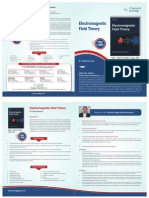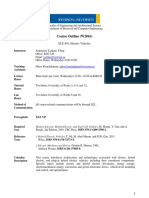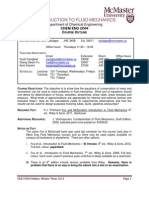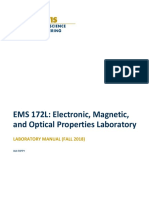Professional Documents
Culture Documents
Info Sheet
Info Sheet
Uploaded by
zujovOriginal Description:
Copyright
Available Formats
Share this document
Did you find this document useful?
Is this content inappropriate?
Report this DocumentCopyright:
Available Formats
Info Sheet
Info Sheet
Uploaded by
zujovCopyright:
Available Formats
EE 214000 Electromagnetics
Spring 2011
Information Sheet
Lecturer: Prof. Shang-Da Yang (楊尚達)
Office: EECS 512 (資電 512)
Email: shangda@ee.nthu.edu.tw
Course website: http://www.ee.nthu.edu.tw/~sdyang/Courses/EM.htm
Class time: M3M4, W2
Office hours: Wednesday 10-11 AM, EECS 512
Head of TAs: 許呈韶, okelddo@gmail.com, Tel: 0911-682-138, NTHU ext. 34177
TA hours: Monday 7-9 PM, R118, Engineering Building III (工程三館 118)
■ Textbooks & References
David K. Cheng, Field and Wave Electromagnetics, 2nd edition, Addison Wesley, 1989.
Shang-Da Yang, Lecture Notes, pdf files are available on the course website.
Umran S. Inan, and Aziz S. Inan, Engineering Electromagnetics, Addison Wesley, 1999.
■ Syllabus:
1. Introduction & transmission lines (8 hours: 2/21, 2/23, 2/28 和平紀念日, 3/2, 3/7, 3/9,
3/14)
2. Vector analysis (4 hours: 3/14, 3/16, 3/21)
3. Midterm exam 1 (3/28 evening)
4. Electrostatics in free space (3 hours: 3/23, 3/28)
5. Electrostatics in materials (3 hours: , 3/30, 4/4 校際活動週, 4/6, 4/11)
6. Capacitance, electrostatic energy (3 hours: 4/11, 4/13, 4/18)
7. Static electric currents (3 hours: 4/18, 4/20, 4/25, the 2nd hour of 4/25 as reservation)
8. Midterm exam 2 (5/2)
9. Magnetostatics in free space (3 hours: 4/27, 5/4 遇 CLEO 停課, 5/9)
10. Magnetostatics in materials (3 hours: 5/11, 5/16)
11. Inductance, magnetostatic energy (2 hours: 5/18, 5/23)
12. Introduction to Maxwell's equations (2 hours: 5/23, 5/25)
13. Wave equations (3 hours: 5/30, 6/1)
14. Plane waves (6 hours: 6/6, 6/8, 6/13, 6/15)
15. Final exam (6/20)
■ Grading Policies:
1. Homework (20%): Once in every two lessons. Delayed submission will not be counted.
2. Quizzes (20%): Irregular, but will be announced in advance. Questions will come from
examples of textbook or homework questions.
3. Midterm exam 1 (15%): Tentatively scheduled on 3/28 (evening), covering transmission
lines and vector analysis.
4. Midterm exam 2 (15%): Tentatively scheduled on 5/2 (class hours), covering
electrostatics and static currents.
5. Final exam (30%): Tentatively scheduled on 6/20, covering magnetostatics, and
electro-magnetodynamics.
6. Bonus points: Properly answering one bonus question in class may earn 1-3 points of
semester score. Presence & thinking are encouraged.
■ Special Comments:
1. This course is most appropriate for those who have taken circuit theory, ordinary and
partial differential equations, and Fourier transforms.
2. Capability of using math software (e.g. Matlab) is necessary in homework assignments.
3. Exam questions about transmission lines will solely come from lecture notes and
homework, tracing the related chapters of the textbook is frustrating and unnecessary.
4. The purpose of this course is to “reorganize” your existing knowledge about
electromagnetics in a systematic manner. Starting from the four fundamental postulates
(Maxwell’s equations), all experimental laws can be places under a united hierarchy.
5. The textbook is well written and worth reading line by line. The lecture notes are
designed to summarize the key topics with minimal number of examples, which can be
used as a guideline of studying. Examining more examples from the textbook by yourself
is strongly recommended.
6. Some of important topics will be investigated in homework for lack of lecture time. They
will be present in quizzes and exams.
7. The homework questions will be less complicated than those of the previous years. You
are not supposed to solve them perfectly, however, practicing them independently is
essential to consolidate your understanding.
8. There are too many formulas in electromagnetics, and repeating them from memory does
not help in the long term. The key to success is “visualizing” the formulas, which relies
on understanding of vector analysis.
9. One can hardly expect to get familiar with Electromagnetics within one semester. You are
encouraged to review it again and again. The same line may impress you with different
meanings in successive times of reviewing.
You might also like
- ENC 1102 Final ReflectionDocument4 pagesENC 1102 Final ReflectionAJ StockwellNo ratings yet
- Book Review Dead ReckoningDocument10 pagesBook Review Dead Reckoningfaizan100% (1)
- Compliance Monitoring Report New FormatDocument5 pagesCompliance Monitoring Report New FormatPatrick Antony Ngojo100% (1)
- Formal Lesson Plan Ela First GradeDocument5 pagesFormal Lesson Plan Ela First Gradeapi-463700896100% (1)
- (John Carter) Sex and Rockets The Occult World of PDFDocument264 pages(John Carter) Sex and Rockets The Occult World of PDFshoula80% (5)
- Electromagnetic Field TheoryDocument2 pagesElectromagnetic Field TheoryKeith Fernandes0% (1)
- MATSCIE 554 (CHE 554) - Computational Methods in MATSCIE and CHEDocument5 pagesMATSCIE 554 (CHE 554) - Computational Methods in MATSCIE and CHEyao_12No ratings yet
- ECE2 Syllabusoutline 2019Document3 pagesECE2 Syllabusoutline 2019john iceNo ratings yet
- LUMS EE - 3rd Year Course OutlinesDocument34 pagesLUMS EE - 3rd Year Course OutlinesAhsan Ahmed MoinNo ratings yet
- EE3001 Engineering Electromagnetics - OBTLDocument7 pagesEE3001 Engineering Electromagnetics - OBTLAaron TanNo ratings yet
- Math2zz3 OutlineDocument4 pagesMath2zz3 OutlineSalma El-hossanNo ratings yet
- Introduction to Electromagnetic EngineeringFrom EverandIntroduction to Electromagnetic EngineeringRating: 5 out of 5 stars5/5 (1)
- ECE341 Fall 2016 SyllabusDocument8 pagesECE341 Fall 2016 SyllabusMuhammad Abdul JabbarNo ratings yet
- IM ECEN 30104 ElectromagneticsDocument109 pagesIM ECEN 30104 ElectromagneticsEm Reyes100% (1)
- Department of Electrical & Computer Engineering: Graduate Course OutlineDocument3 pagesDepartment of Electrical & Computer Engineering: Graduate Course OutlinekasunkalharaNo ratings yet
- Emwc Course PM 2022 v2Document6 pagesEmwc Course PM 2022 v2Sergio PazNo ratings yet
- ECE230L Syllabus Spring 2018 Brown Version 2Document4 pagesECE230L Syllabus Spring 2018 Brown Version 2Abby WoodNo ratings yet
- Phyb21H: Electricity and MagnetismDocument4 pagesPhyb21H: Electricity and MagnetismShravan PrajapatiNo ratings yet
- ASIIbDocument3 pagesASIIbKris BuchananNo ratings yet
- Heat Treansfer Note University of Florida - 2013Document175 pagesHeat Treansfer Note University of Florida - 2013Suta VijayaNo ratings yet
- StudyGuide 5EPA0Document27 pagesStudyGuide 5EPA0youri.smoldersNo ratings yet
- Debre Tabor University: Faculty of TechnologyDocument10 pagesDebre Tabor University: Faculty of TechnologyVenkata DineshNo ratings yet
- ELEC3106 Electronics: Course StaffDocument10 pagesELEC3106 Electronics: Course StaffAlex HugoirNo ratings yet
- FEE322 Lecture 1 - IntroductionDocument8 pagesFEE322 Lecture 1 - Introductionali aziadNo ratings yet
- Molecular Mechanics 2018Document3 pagesMolecular Mechanics 2018calebNo ratings yet
- Ecng3022 Sem2 Self Study Exercise3 1819Document4 pagesEcng3022 Sem2 Self Study Exercise3 1819limber dameciousNo ratings yet
- Syllabus of Electromagnetic+Engineering+TranCaoQuyenDocument6 pagesSyllabus of Electromagnetic+Engineering+TranCaoQuyen21021618 Vương Hoàng MinhNo ratings yet
- EE4382 FA 2017 Syllabus v1Document5 pagesEE4382 FA 2017 Syllabus v1Mahmoud IsmailNo ratings yet
- Engr 213 Outline 2014 Judy-2Document3 pagesEngr 213 Outline 2014 Judy-2Ahad HaiderNo ratings yet
- 2015 Spring MSE2001 Syllabus ScheduleDocument6 pages2015 Spring MSE2001 Syllabus ScheduleSamuel DiazNo ratings yet
- ELE 801 Electric Vehicles Outline AYDocument4 pagesELE 801 Electric Vehicles Outline AYgui0381No ratings yet
- Physics 2B Fall 2016 Section Course Information/Syllabus: AnnouncementsDocument5 pagesPhysics 2B Fall 2016 Section Course Information/Syllabus: AnnouncementsHamza SaleemNo ratings yet
- Handout Py2301 EceDocument1 pageHandout Py2301 EceArkaprabha BasuNo ratings yet
- ABET Syllabus 2014 EEL 5382Document3 pagesABET Syllabus 2014 EEL 5382yeswanth varma kanumuriNo ratings yet
- Enhancing Electromagnetics Instruction Using Matlab and MathcadDocument12 pagesEnhancing Electromagnetics Instruction Using Matlab and MathcadpuceiroaleNo ratings yet
- Ecng3022 Sem2 Week2 Activity Guide 1819Document4 pagesEcng3022 Sem2 Week2 Activity Guide 1819limber dameciousNo ratings yet
- Electrical Circuit Analysis & Network Theory AICTE BookDocument338 pagesElectrical Circuit Analysis & Network Theory AICTE BookNivedetha B - PSGCTNo ratings yet
- Mie1620hDocument2 pagesMie1620hShreyas ChoudharyNo ratings yet
- EE 564-Stochastic Systems-Momin UppalDocument3 pagesEE 564-Stochastic Systems-Momin UppalWaseem AbbasNo ratings yet
- Lecture Notes W2021Document104 pagesLecture Notes W2021SamNo ratings yet
- UT Dallas Syllabus For Phys3352.501.07s Taught by Anvar Zakhidov (Zakhidov)Document7 pagesUT Dallas Syllabus For Phys3352.501.07s Taught by Anvar Zakhidov (Zakhidov)UT Dallas Provost's Technology GroupNo ratings yet
- Tel. 392-4242 E-Mail:: Rakov@ece - Ufl.eduDocument6 pagesTel. 392-4242 E-Mail:: Rakov@ece - Ufl.eduJordan EhrenNo ratings yet
- 2012 PGT Physics Part1Document120 pages2012 PGT Physics Part1Sheetal YadavNo ratings yet
- Course Profile Elec Eng 2011 Circuit AnalysisDocument8 pagesCourse Profile Elec Eng 2011 Circuit AnalysisLarry Gerard AquinoNo ratings yet
- TO Fluid Mechanics: Department of Chemical EngineeringDocument6 pagesTO Fluid Mechanics: Department of Chemical EngineeringMas KumambangNo ratings yet
- Power Electronics: University of AlcaláDocument9 pagesPower Electronics: University of AlcaláHassanNo ratings yet
- EMS 172L Syllabus and Reference Guide PDFDocument13 pagesEMS 172L Syllabus and Reference Guide PDFindigoincNo ratings yet
- Syllabus: Course Objectives & DescriptionDocument2 pagesSyllabus: Course Objectives & DescriptionFITRA AULIANo ratings yet
- Vật Liệu Và Linh Kiện Điện Tử (Electronic Materials) COURSE ID: 402057Document8 pagesVật Liệu Và Linh Kiện Điện Tử (Electronic Materials) COURSE ID: 402057Sơn Thanh ThanhNo ratings yet
- Structural Analysis Notes 32Document105 pagesStructural Analysis Notes 32Alexander Appiah OkoreNo ratings yet
- First Course Handout Physics 2Document3 pagesFirst Course Handout Physics 2Kuljeet YadavNo ratings yet
- Introduction To Electronics and Electrical Power & Machines: Dr. Hoon Yap Yap - Hoon@taylors - Edu.my C9.25 Ext. 5251Document9 pagesIntroduction To Electronics and Electrical Power & Machines: Dr. Hoon Yap Yap - Hoon@taylors - Edu.my C9.25 Ext. 5251Covyn YongNo ratings yet
- Solved Problems in Electromagnetics (2017)Document813 pagesSolved Problems in Electromagnetics (2017)charan467100% (7)
- Developing Laboratory Courses in A ResouDocument4 pagesDeveloping Laboratory Courses in A ResoushireenfNo ratings yet
- Lecture Notes 1Document7 pagesLecture Notes 1Katherina PetersenNo ratings yet
- De ZG513Document8 pagesDe ZG513inderNo ratings yet
- Ateneo de Manila University Loyola Schools Course Syllabus: Timeline Lecture Topics Laboratory ActivitiesDocument3 pagesAteneo de Manila University Loyola Schools Course Syllabus: Timeline Lecture Topics Laboratory ActivitiesJuan Glicerio C. ManlapazNo ratings yet
- Electric Circuits & Networks Suresh Kumar K.S: Reference URLDocument28 pagesElectric Circuits & Networks Suresh Kumar K.S: Reference URLsreekantha2013No ratings yet
- 210 Syllabus - Fall 2014Document5 pages210 Syllabus - Fall 2014DannyKrupaNo ratings yet
- Hướng Dẫn Visio 2013Document2 pagesHướng Dẫn Visio 2013dtdatnaNo ratings yet
- Ee426/506 Communication Theory: Spring 2015Document3 pagesEe426/506 Communication Theory: Spring 2015MohammedNo ratings yet
- Advanced Finite Elements: ME EN 7540 Syllabus Spring 2006Document4 pagesAdvanced Finite Elements: ME EN 7540 Syllabus Spring 2006Shivan DoskyNo ratings yet
- ELEC4612-T1-2019 Course Outline PDFDocument10 pagesELEC4612-T1-2019 Course Outline PDFtekliye getuNo ratings yet
- Science 4Th Term Boston International School: Colombian Biodiversity Flora, Fauna and AnimalsDocument18 pagesScience 4Th Term Boston International School: Colombian Biodiversity Flora, Fauna and AnimalsCristianNoriegaNo ratings yet
- Pile Cap Balanced LoadsDocument1 pagePile Cap Balanced LoadsKausik DewanNo ratings yet
- Basic Radiobiology (Slides) PDFDocument44 pagesBasic Radiobiology (Slides) PDFSuhey07100% (2)
- Security Report Writing v4Document24 pagesSecurity Report Writing v4ambani gaudenciaNo ratings yet
- Statically Indeterminate Structures Chu Kia Wang PHD RDocument3 pagesStatically Indeterminate Structures Chu Kia Wang PHD RWaQar SaleemNo ratings yet
- Read Also: 1. What Is Life Short Essay?: Essay On Journey by Train For StudentsDocument4 pagesRead Also: 1. What Is Life Short Essay?: Essay On Journey by Train For StudentsGel HyperNo ratings yet
- Application For Leave at The SCCGuideDocument10 pagesApplication For Leave at The SCCGuideManasi HansaNo ratings yet
- Steven Mark M. Alap: AccomplishmentsDocument2 pagesSteven Mark M. Alap: AccomplishmentsumbrakaitoNo ratings yet
- Flight Attendant Interview QuestionsDocument2 pagesFlight Attendant Interview QuestionsDaiane Rafael BindaNo ratings yet
- Notes For EM416 & EA302 Engineering ManagementDocument8 pagesNotes For EM416 & EA302 Engineering ManagementYao SsengssNo ratings yet
- Camera BagDocument196 pagesCamera BagLinggawatiAditopoNo ratings yet
- Step 1: Concept/functional Plan: Gail HansenDocument10 pagesStep 1: Concept/functional Plan: Gail HansenjhayNo ratings yet
- Media and Information Literacy MilDocument61 pagesMedia and Information Literacy MilLerwin Garinga100% (2)
- Building Maintenance Issues A MalaysianDocument18 pagesBuilding Maintenance Issues A MalaysianNurSyuhadaAhmadNo ratings yet
- Types of ScalesDocument8 pagesTypes of ScalesBahrouniNo ratings yet
- Sacred Ecology - Traditional Ecological Knowledge and Resource Management.Document2 pagesSacred Ecology - Traditional Ecological Knowledge and Resource Management.Rodrigo SalgueroNo ratings yet
- Simplechip Plus Enzymatic Chromatin Ip Kit (Magnetic Beads)Document8 pagesSimplechip Plus Enzymatic Chromatin Ip Kit (Magnetic Beads)chan ka yuNo ratings yet
- Sources of Elastic Deformation in Steel Frame and Framed-Tube Structures: Part 1: Simplified Subassemblage ModelsDocument14 pagesSources of Elastic Deformation in Steel Frame and Framed-Tube Structures: Part 1: Simplified Subassemblage ModelsAvi AuslenderNo ratings yet
- Hci-1 Chapter 11 AssignmentDocument2 pagesHci-1 Chapter 11 Assignmentandrea mercadoNo ratings yet
- Roger W. Hecht - Only Yesterday - Ecological and Psychological Recovery (Project MUSE)Document7 pagesRoger W. Hecht - Only Yesterday - Ecological and Psychological Recovery (Project MUSE)LustmordNo ratings yet
- STAT 480b Answer Key To Problem Set No. 4Document3 pagesSTAT 480b Answer Key To Problem Set No. 4Robinson Ortega MezaNo ratings yet
- Siemens SettingsDocument45 pagesSiemens SettingstajudeenNo ratings yet
- CSE-PPT Room Assignment CARAGA (Butuan City) ProfessionalDocument276 pagesCSE-PPT Room Assignment CARAGA (Butuan City) ProfessionalPhilNewsXYZNo ratings yet
- Base Flow Separation by The Conductivity Mass Balance Method Martin CommentsDocument12 pagesBase Flow Separation by The Conductivity Mass Balance Method Martin Commentsapi-302897054No ratings yet
- The First Cartographic Representations o PDFDocument11 pagesThe First Cartographic Representations o PDFTas Varga100% (1)

























































































